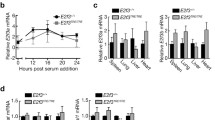Abstract.
Generation of genetically engineered mice with either gain-of-function or loss-of-function mutations is the most popular technique for determining gene functions and the interrelationship between molecules in vivo. These models have provided a wealth of information about the developmental and physiological roles of oncogenes and growth factors. To date, transgenic techniques have been used extensively to study the functions of the epidermal growth factor (EGF) family. This review highlights some of the major recent findings pertinent to the EGF receptor (EGFR) and its ligands with special reference to elucidating how EGF and its related growth factors work together to regulate reproduction, growth and development. Finally, future investigations on ligand-ligand communications, EGFR and its ligands in neural stem cell research, and the mechanisms of EGFR signaling and trafficking in cells are also suggested.
Similar content being viewed by others
Author information
Authors and Affiliations
Additional information
Received 24 May 2002; received after revision 15 July 2002; accepted 16 July 2002
Rights and permissions
About this article
Cite this article
Wong, R. Transgenic and knock-out mice for deciphering the roles of EGFR ligands. CMLS, Cell. Mol. Life Sci. 60, 113–118 (2003). https://doi.org/10.1007/s000180300007
Issue Date:
DOI: https://doi.org/10.1007/s000180300007




